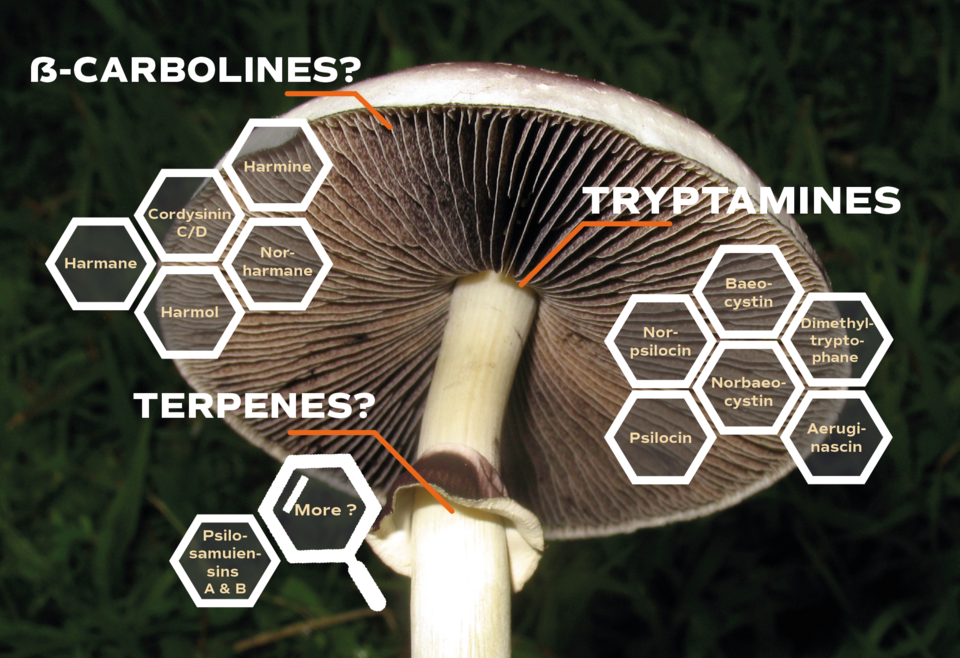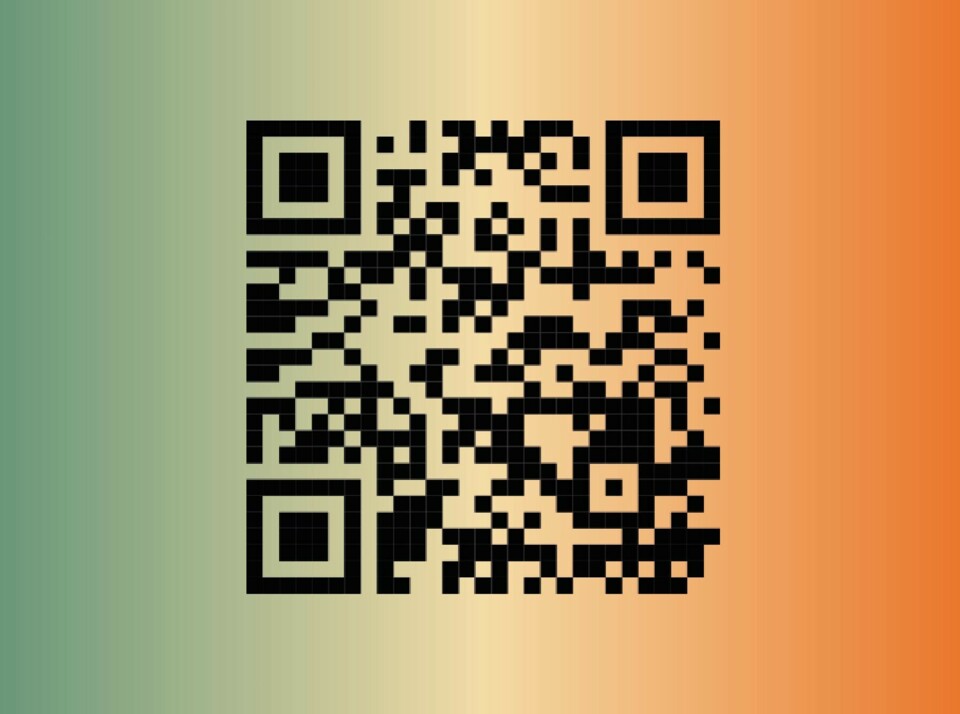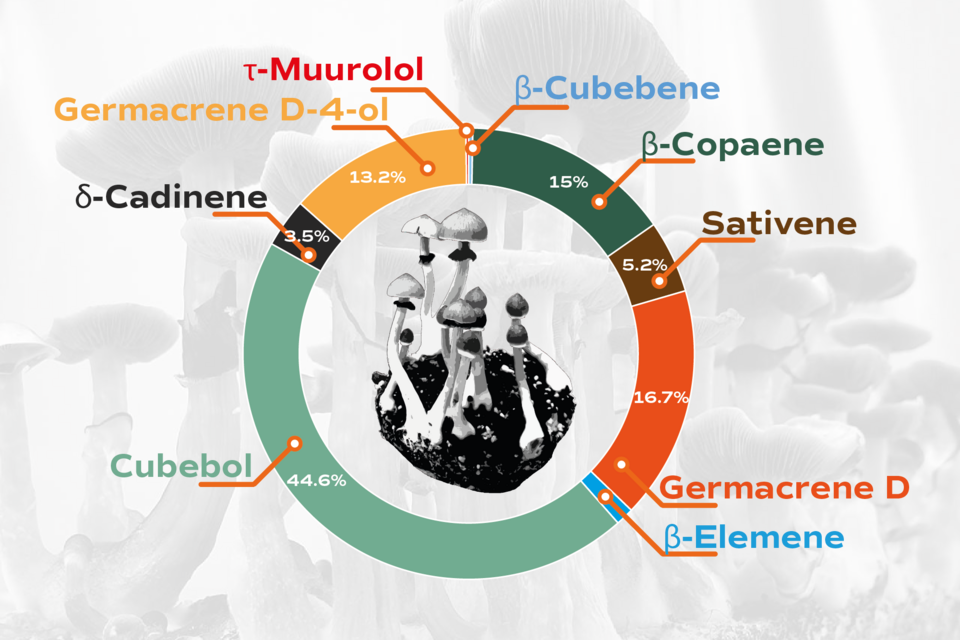
miraculix Community Research
With our QTests, which allow quantifying the concentration of psychedelic compounds, a big opportunity for research arises. Together with the Psychedelic Substances Research Group from the Charité Berlin, we work on an exciting new project:
Together we investigate the psychedelic experience induced by Magic Mushrooms and LSD, including data such as the measured concentration of active ingredients, body weight, gender, and prior experience with psychedelics. Previous studies have often not considered such variables, but we want to change that.
Particularly, we want to focus on exploring the so-called entourage effect in psychedelic mushrooms.
What is the Entourage Effect?
The term Entourage Effect was first established by Dr. Ethan Russo and comes primarily from research on the cannabis plant. The hypothesis here is that the combination of various cannabinoids, terpenes, and other metabolites strongly influences the effect of the main active ingredient THC (Russo, 2011).
Why should this now play a role in psilocybin-containing mushrooms?
Significant research by our scientist Dr. Felix Blei found that magic mushrooms contain many other compounds besides tryptamine alkaloids, such as potentially active secondary metabolites like harmane and harmine (Blei et al., 2020). Additionally, there are also several (as yet) undiscovered terpenes in the chemical repertoire of these mushrooms (Scháfer et al., 2023). This is particularly exciting as minor mono- and sesquiterpenes in cannabis seem to modulate the activity of major psychotropic metabolites (Booth et al., 2017).


Different Mushroom Strains = Different Effects?
The Entourage Effect could therefore explain the highly variable effects of different psilocybin-containing mushroom species or strains. Anecdotal reports claim that individual mushroom species produce different effects in for example the visual or cognitive domain of the psychedelic experience (Gartz, 1989). Do you feel similarly and can report clear differences between the effects of different species/strains?
To test this idea, we developed a new questionnaire assessing the psychedelic experiences induced by magic mushrooms. This questionnaire is easy to understand, quick to complete, and completely anonymous.
Single Agent vs. Full-Spectrum
The Entourage Effect presents an interesting avenue for future research. Together with recent advancements in clinical research on psilocybin as an alternative treatment for mental health disorders (Daniel & Haberman, 2017; Roseman et al., 2018), some critical questions arise:
Do the (therapeutic) effects of different species of magic mushrooms differ from those of pure psilocybin? Do different strains of magic mushrooms have different therapeutic potential? Will future psychedelic therapy use the whole fungus or isolated psilocybin? If you had the choice, would you, like many medical cannabis patients, prefer a full-spectrum administration over a single agent?
These are the questions we are trying to answer with our community research project!


Be Part of Our Community Research
With our Psilocybin QTest, you can test psychedelic mushrooms for their psilocybin/psilocin content for the first time. By reporting the results from your analysis and answering questions about your psychedelic experience, you can be part of our community research project!
We are excited to allow our community to independently advance psychedelic research and science.
Together we can find out how psilocybin contents are distributed across the many mushroom species that occur in nature. Finally, data can show whether different mushroom species or strains produce different experiences. Large-scale follow-up community projects could investigate the effects of various influences such as substrate, genetics or environmental factors.
First Terpenes in Shrooms
In a collaboration between the University of Jena and the local HKI and MPI, Eike Schäfer and colleagues were able to show the production of over nine different terpenes, including β-copaene and δ-cadinene in the fruiting bodies of Psilocybe cubensis. You can see which terpenes were also found in the in-vitro product assays of P. cubensis in the graphic.
However, it was not only possible to detect these terpenes, but also how the fungi produce these known natural substances. The enzyme CubA was identified as a multifunctional sesquiterpene synthase. CubA was four-fold upregulated in fruiting bodies vs. vegetative mycelium, which pointed to a function of this gene in the mushrooms.

Other studies
Other Scientific Projects
We would also like to push additional important psychedelic science from other researchers/universities, which are looking for participants. Find further current studies from international universities in the section below, where you could make an important contribution to science. The more participants for scientific studies, the better! So help with your experiences and spread the word for science!

Dose-response study on the subjective effects of LSD and Psilocybin: Charité – University Medicine Berlin
About the study: The dose-dependent subjective experiences induced by LSD or Psilocybin, particularly for higher dosages, are still unclear. For the first time, QTests allow for the assessment of dose-specific effects in recreational users outside of a clinical study setting. The Charité – University Medicine Berlin investigates how the dose and other variables shape the subjective experience. The results can help to reduce harms and improve treatment efficacy in psychedelic-assisted psychotherapy.
How to help: By sharing your QTest result and filling out two validated questionnaires that are commonly used in clinical studies, you can reflect on the content of your experience and greatly enhance the scientific understanding of altered states of consciousness. You can also participate multiple times and share each individual experience with the corresponding QTest result.
Join now: The two validated questionnaires are part of the QTest-Survey on LSD and psilocybin. You are free to skip questionnaires that are not of interest to you. Further information can be found on the survey page.

LSD Afterglow Study: Charité – University Medicine Berlin
About the study: The Charité – University Medicine Berlin investigates the changes in mood and subjective experiences that individuals encounter in the days following the consumption of psychoactive substances. With a newly developed tool, the Afterglow-Inventory, they like to find out how the after-effects vary across different substances.
How to help: By sharing your overall experience with either LSD or psilocybin and filling out the 24-item Afterglow-Inventory, you contribute to a better understanding of the afterglow phenomenon.
Join now: The Afterglow Study is part of the general survey on the subjective experiences of LSD and psilocybin that are linked to your QTest results. For further information, visit the survey page.

The Mushroom Experience Project – A Comparative Study of Psilocybin Species
About the study: This survey is conducted by independent researcher Sam, PhD ecologist and science communicator, in collaboration with Dr. Matthias Forstmann from the University of Zurich. The study seeks to identify patterns and distinctions in the subjective experiences elicited by various psilocybin mushroom species. The study addresses key questions such as: Do different species cause different subjective effects? Do certain effects consistently co-occur? Can species be grouped into clusters based on their effects? Your input as an experienced user is essential to help discern these patterns and enhance understanding in the field of fungal psychopharmacology, especially for species that are less frequently studied.
How to help: If you have used one or more species of psilocybin mushrooms in the past 12 months, your feedback is invaluable. The survey asks you to select the species you've used and describe your typical experiences, focusing on sensory perceptions, cognitive shifts, and emotional responses. Your responses will contribute to a more comprehensive understanding of potential variations in effects across species and help inform future research, possibly leading to blinded studies in places like Colorado.
Join now: Participate in supporting this independent research initiative and share your experiences to help uncover patterns and contribute to the evolving field of psychedelic research. Your insights are essential for identifying the subtle distinctions that may exist across different psilocybin mushroom species. Further details and links to previous research can be found through the provided resources.
SOURCES:
Fricke, J., Blei, F., & Hoffmeister, D. (2017). Enzymatic synthesis of psilocybin. Angewandte Chemie International Edition, 56(40), 12352–12355. https://doi.org/10.1002/anie.201705489
Daniel, J., & Haberman, M. (2017). Clinical potential of psilocybin as a treatment for mental health conditions. The Mental Health Clinician, 7(1), 24–28. https://doi.org/10.9740/mhc.2017.01.024
Roseman, L., Nutt, D., & Carhart‐Harris, R. (2018). Quality of acute psychedelic experience predicts therapeutic efficacy of psilocybin for Treatment-Resistant Depression. Frontiers in Pharmacology, 8. https://doi.org/10.3389/fphar.2017.00974
Russo, E. B. (2011). Taming THC: potential cannabis synergy and phytocannabinoid‐terpenoid entourage effects. British Journal of Pharmacology, 163(7), 1344–1364. https://doi.org/10.1111/j.1476-5381.2011.01238.x
Booth, J. K., Page, J. E., & Bohlmann, J. (2017). Terpene synthases from Cannabis sativa. PLOS ONE, 12(3), e0173911. https://doi.org/10.1371/journal.pone.0173911
Gartz J. Analysis of Aeruginascin in Fruit Bodies of the Mushroom Inocybe aeruginascens. International Journal of Crude Drug Research. 1989;27(3):141-4.
Scháfer, E., Seibold, P. S., Bartram, S., Trottmann, F., Haensch, V. G., Gressler, M., Chadeayne, A., Hertweck, C., O’Connor, S. E., & Hoffmeister, D. (2023). A „Magic Mushroom“ Multi‐Product sesquiterpene synthase. ChemBioChem, 24(21). https://doi.org/10.1002/cbic.202300511
Questions about our community research?
Do you have a question about our community research project? Just send us a message and we'll get back to you as soon as possible!